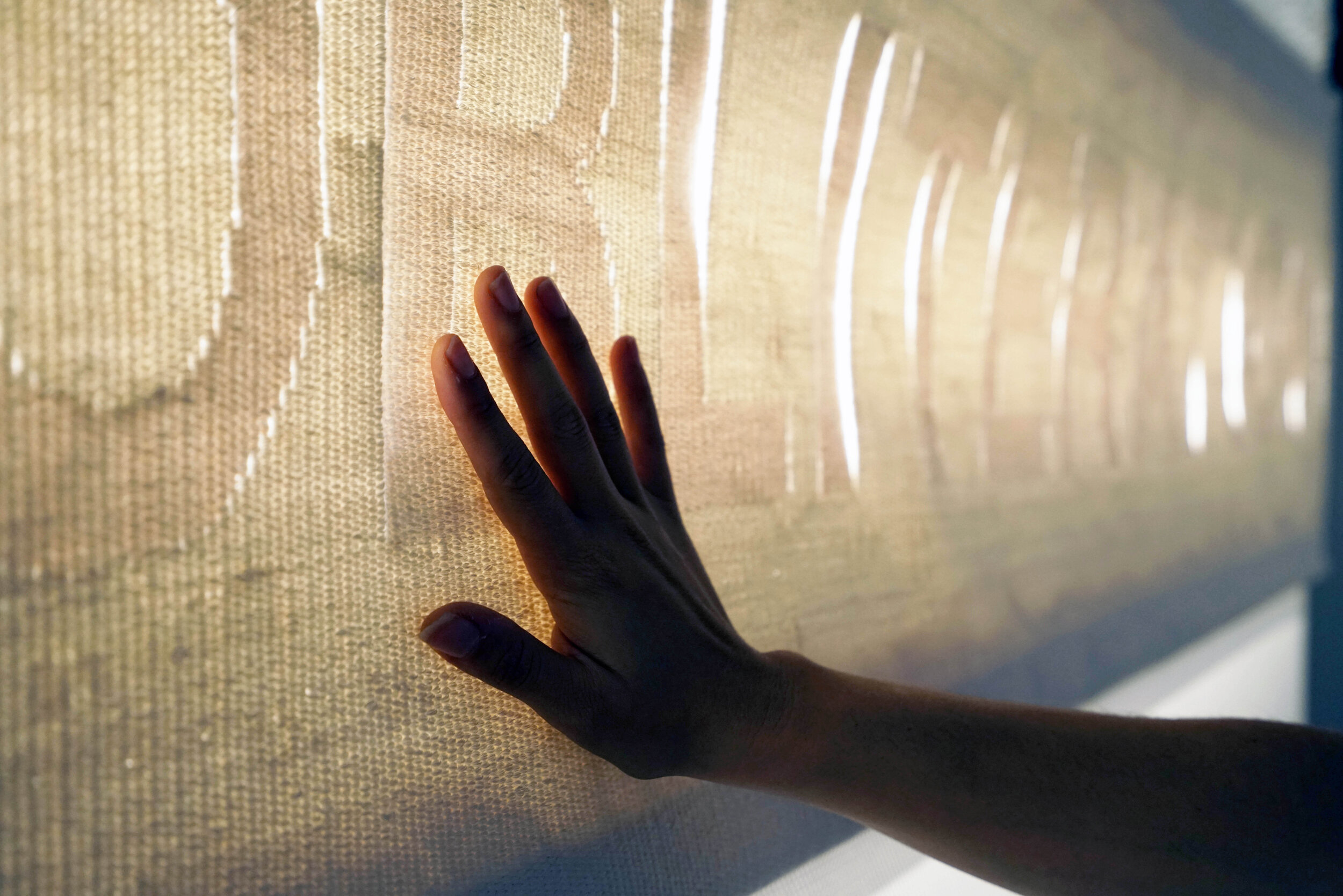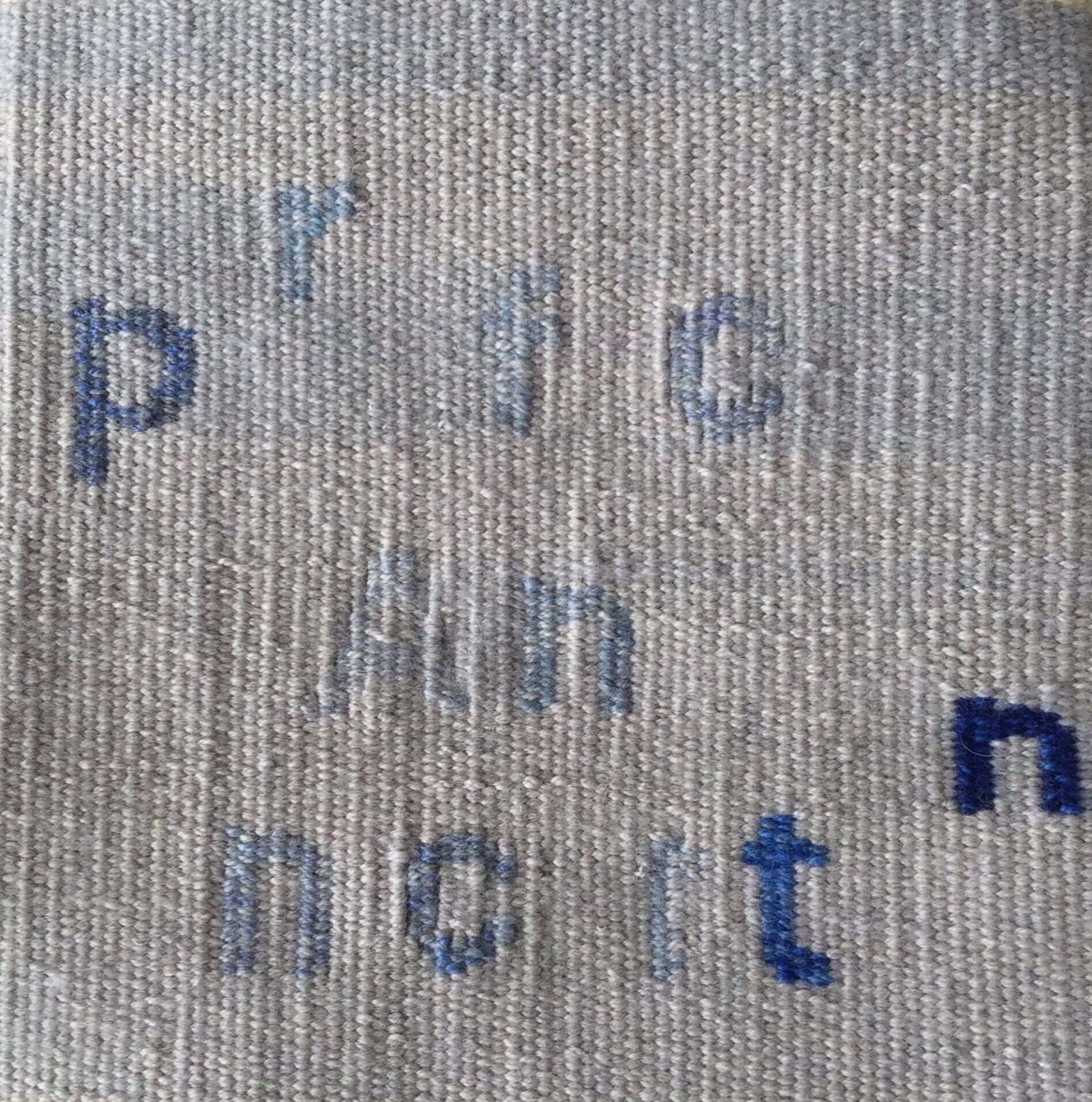Chloe Bensahel blends performance, textiles and multimedia to highlight the relationship between language and identity. Inspired by her own inter-generational history of migration, her work investigates narration partnered with material traditions to give way to embodied or coded language. Recent works include collaborations with emerging technologies (Google Jacquard) to allow textiles to speak via touch.
Bensahel was recently awarded a Smithsonian Artist Research Fellowship (2021) to look at the historical relationship between early memory technology (core memory) and metallic lace.
For more information, please see: www.chloebensahel.com and Instagram @chloebensahel.
Chloe Bensahel, Words Weave Worlds (detail), 2019. Interactive installation, metal, LEDs, linen tapestries and Google Jacquard thread, sound system. Audio composed and sung by Caroline Shaw, Programming and engineering Jonathan Tanant and Olivier Bau. 13 ft x 13 ft x 30 ft. Image courtesy of the artist.
First, and most importantly, how are you doing? How are you navigating the highs and lows?
I’m pretty good - the discomfort comes in waves. This moment feels very connected to fragility. For some, fragility has been a daily struggle that is finally being seen, and for others it’s being felt for the first time. I recently read letter exchanges between Sol Lewitt and Eva Hesse, “relax and let everything go to hell — you are not responsible for the world — you are only responsible for your work — so DO IT.” It feels good to focus on the work.
I’ve had to adapt a little bit (like everyone I’m sure!) I was supposed to start a fellowship at the Smithsonian in September, which keeps getting rescheduled. I built a tapestry loom to keep working on projects. I also took an arduino programming course. I’m using this space as a moment to reflect and try new things. I’m also trying to make time for rest, taking in the good.
Chloe Bensahel, Words Weave Worlds, 2019. Interactive installation, metal, LEDs, linen tapestries and Google Jacquard thread, sound system. Audio composed and sung by Caroline Shaw, Programming and engineering Jonathan Tanant and Olivier Bau. 13 ft x 13 ft x 30 ft. Image courtesy of the artist.
Chloe Bensahel, Words Weave Worlds (detail), 2019. Interactive installation, metal, LEDs, linen tapestries and Google Jacquard thread, sound system. Audio composed and sung by Caroline Shaw, Programming and engineering Jonathan Tanant and Olivier Bau. 13 ft x 13 ft x 30 ft. Image courtesy of the artist.
Chloe Bensahel, Words Weave Worlds (detail), 2019. Interactive installation, metal, LEDs, linen tapestries and Google Jacquard thread, sound system. Audio composed and sung by Caroline Shaw, Programming and engineering Jonathan Tanant and Olivier Bau. 13 ft x 13 ft x 30 ft. Image courtesy of the artist.
It's my experience that most artists engage with some level of self-isolation in their day to day art practice. Has this been your experience? And if so, have you found these innate rhythms to be helpful during this larger, world-wide experience of isolation?
I like working in isolation in doses, like when I’m weaving or embroidering, after a few hours, the body sort of adapts and does it on its own. I’m actually used to working alongside other people, in a studio or atelier environment. At the Manufacture de Beauvais in Paris, I work in a room with other weavers and students so there are always little chats and technical discussions. In the past months, I’ve been working in DC in a co-working space (Halcyon Arts Lab) so I’m still with other people, startups actually, so the contrast is pretty funny. I feel like a lot of textile work has historically been done in community so I don’t find it natural to work in isolation. For me, the intimacy of textiles is very tied to how they allow us to connect to one another, which has been extremely lacking at the moment. The fact that we can’t touch one another is tragic on so many levels – it’s not a bonus sense. That said, it’s also been really wonderful to have that space alone to reflect on what I want to make, without working towards a show or anything. I’m working on a performance based on touching parts of one’s body to tell one’s history.
Tapestry weaving with shuttles and cartoon. Image courtesy of the artist.
Hand-made Loom, Washington, DC Halcyon Arts Lab. Image courtesy of the artist.
Workspace at the Manufacture de Beauvais. Image courtesy of the artist.
It would be great if you could briefly talk us through your practice. Understanding it is integral to appreciating the multivalence of your work.
I work in textiles, performance, and technology to consider language as it relates to the self in this cross-cultural and migratory era. I’m the last of four generations of immigrants, a journey that has taken my family from Algeria all the way to the U.S. via Morocco and France. I’m interested in the complex histories that we all carry in our bodies.
In “Veste Quae Ex, Dobus Texta Est, Non Indueris,” for example, textile labor of stripping and weaving become tools of undoing a long history of stripes as a motif associated with the “impure” or “outsider.” In other instances, the textile gesture becomes the subject of the work, as in “Je Tisse Mon Histoire,” where I undo my own stigmatized labels in favor of an abstract and intertwined one, inspired by the double meaning of “histoire” for story and history. More recent work places gesture and performance at the center of how language becomes narrative through the use of interactive (smart) textile technologies. “Words Weave Worlds” is an interactive tapestry installation made in collaboration with France’s National Tapestry Workshop and Google Arts and Culture, that presents a series of words that are revealed through touch and hearing rather than sight. Such words deal with the positive and negative associations of white, with sound compositions by Caroline Shaw.
Chloe Bensahel, Veste Quae Ex Dobus Texta Est Non Indueris (detail), 2018. 13 striped menswear shirts stripped and rewoven, embroidery, each textile around 55 cm x 61 cm. Text from Leviticus that inspired prisoner uniforms. Image courtesy of the artist.
Chloe Bensahel, Veste Quae Ex Dobus Texta Est Non Indueris, 2018. 13 striped menswear shirts stripped and rewoven, embroidery, each textile around 55 cm x 61 cm. Text from Leviticus that inspired prisoner uniforms. Image courtesy of the artist.
Chloe Bensahel, Je Tisse Mon Histoire, 2018. Performance, backstrap loom, menswear shirt, wool embroidery, linen thread. Duration: 3:00:00. Image courtesy of the artist. Slang terms for “Arab” and “Jew” undone from the artist’s back and woven into an abstract textile.
Has any of your imagery shifted in a reflection to what's currently happening? And why, or why not?
Early in the pandemic, I saw a bunch of stories about nations writing poems to one another on boxes of medical equipment. Even China and Japan, longtime rivals, sent care packages with beautiful poetry on them. All of the poems were somehow related to a shared sense of purpose. I knew that we would soon go back to being separate nations competing so I did a series of weavings with those embedded poems as a way to capture that moment. Those moments made it clear that people have all of the tools to do the right thing, for the environment, for each other, but they choose differently. It’s not about being educated, or having the information, because it’s there. This idea of choice and selective belief is something I’m going to work more on. Interaction is at the center of that work: creating pieces with changing sounds according to where the hand is places responsibility on the viewer. We are responsible.
Chloe Bensahel, Fear Not For The Want of Armor, For Mine is Also Yours to Wear, 2020. Handmade Paper thread, silk, red ink, paper warp. 7 x 14 inches. Image courtesy of the artist.
Are you thinking differently? Coping differently? Inspired differently?
If I’m honest, I thing that the fatigue of residency hopping and moving around so much these last couple of years has finally hit me. There’s this anxiety sometimes being an emerging artist – you want to follow every opportunity you get, god forbid it all shuts down… and it did! I think I realized that I could survive without running around and that’s pretty empowering. This time has definitely made me want stability in my life. I stepped into Sheila Hicks’ studio a couple of years ago, and I remember thinking, “wow that’s the dream.” It’s time to put some roots down.
Chloe Bensahel, We Are the Waves of the Same Sea, We Are the Leaves of the Same Tree, We Are the Flowers of the Same Garden, 2020. Handmade Paper thread, indigo ink, cotton warp. 7 x 11 in each. Image courtesy of the artist.
What is bringing you solace, or even joy, in this moment?
Watching Shirin Neshat films, techno music, embroidery, my friend Mercedes’ chihuahua Papi Chulo, having a good laugh with my partner.
Chloe Bensahel, Foreign Lands Separated By Lands and Rivers, We Share the Wind and Moon Under the Same Sky, 2020. Handmade Paper thread, silk, blue ink. 7 x 11 inches each. Image courtesy of the artist.
What research or writing are you doing that you find compelling?
I recently read Stephen Monteiro’s “The Fabric of Interface” – it’s fascinating how intertwined the history of textiles and technology are. Not only did the first computer come out of jacquard loom weaving technologies, but memory technology, innovations in programming. The field of engineering owes a lot to female women of color who did the manual labor necessary for contemporary technology to come about.
New Tapestry work on perception (letter work) – wool, conductive thread. Image courtesy of the artist.
Are you reading anything?
I’m about to finish “On Earth We Are Briefly Gorgeous” by Ocean Vuong. I cried many times. They depict complex emotions with language unlike anyone else, even commenting on the violence of the language of success: ‘killing it,’ ‘slay,’ ‘bag her,’ ‘bomb’.
Chloe Bensahel. Image courtesy of the artist.















